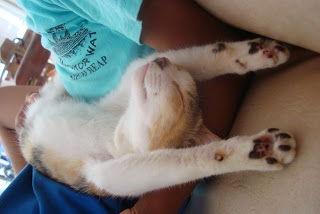Does your cat help you in the garden?
I have a nephew and a niece at home. They are 12 and 15 yrs old. They live with us with my mother. We also have a dog, cats, goats and many chickens. But among them, the cats live with us inside the house. We have 2 females and 1 male cats. Allen call the male as
Pusa, the local term for cats. The females are called
Maripusa and
Muningning. "Muning" is another endearment term for cats. So you can see that all the names denote cats or "pusa". Allen is naughty, so are his cats. But they love each other, Allen love the cats, and the cats love him in return. You might ask how!
Eriel a few years ago, now she is 15.
Kittens are always curious on what people are doing, that somehow they normally become nuisance.
Looks like it is helping Eriel cut the grasses, but when you are not quick you might
cut off its feet when it suddenly lunges on the scissors.
Allen sleeps with his mother and Pusa (male one) has a way of getting to him early dawn unnoticed by anybody. Allen's mom doesnt like cats going to bed, so she always shoo them off before bedtime. However, the cats have silent ways of getting-in unnoticed. It crawls under the sheets, and somehow Allen's hand always find it. So the cat and the hand pet each other under the sheet unnoticed, while Allen was supposed to be sleeping, or is pretending to be so!
The Mom gets off the bed early every morning to prepare for the kids' food and needs for school. Hardly did she realize that an ongoing rendevouz and elicit affair happened at dawn. She realized just recently that it has been ongoing for a long time. And she can't complain but laughed with it.
Muningning when still young and naughty, see it picking on the guinea pigs!
Maripusa (right) is actually the mother of both Pusa and Muningning (on her left)
They give birth maybe 3-4 times per year, and it became a problem to look for
adoptors. The 2 mothers also have 2-4 kittens per delivery.
These are some of the weanlings. Allen and Eriel always have some tears when they part with the kittens, but we cannot afford to have a cathouse: aka people living in a cathouse.
The kittens love sleeping like this, or on top of TV or laptops.
The two females almost always give birth simultaneously, maybe 1-2 wks in between. What is unfathomable but remarkable is that no matter who gave birth first, it always is Maripusa (the older mother) who takes care and feed both her kittens and her grandkittens. Even if Muningning gets her own kits out of the box, Maripusa will surely get them back to nurture them herself. And even if Muningning and Pusa are already both adults, they can also seep her milk once-in-a while if they want. And Maripusa allows them to do so. Can you imagine that from a mother! We shoo them away if very obvious, because the small kittens might be deprived of their rights to have enough milk. However, they still go on with their habits. Muningning can look for new mates because anyway her mother takes care of feeding. So she seems to have kits ahead of her mother most of the time.
Obviously, cat culture is very different from what we culturally know. Remarkable maybe, but incredible!
Allen (left) and Eriel (right) with their kittens.



























































